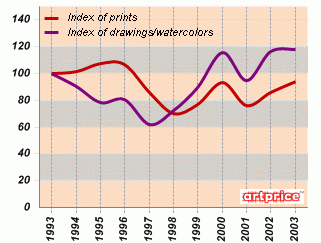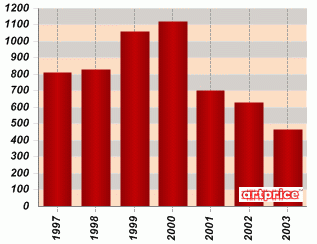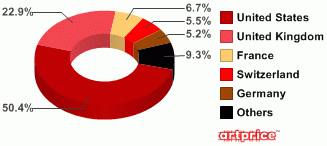Marc Chagall (1887 – 1985): works on paper
[18 Jan 2004]
Thanks to his massive output, Marc Chagall has more works sold at auction than any artist except Pablo Picasso. The most developed segment remains his works on paper representing almost 95% of the lots sold.
Marc Chagall’s childhood, spent in the Jewish ghetto of a Byelorussian town, was steeped in Hassidic culture. In 1907 he started working at the Ecole de Beaux Arts in Saint Petersburg under Bakst, and worked on the sets for Diaghilev’s ballets. In 1911 he left for Paris and settled in la Ruche. Stuck in Vitebsk during the war, he became commissioner for fine arts in his province until Malevich took over and imposed his own vision. He then moved to Moscow where he worked with the Jewish Theatre. From 1923 he devoted himself to etchings in Paris from where he could observe the Nazi’s reaction to his work. His paintings were stripped from the walls of German museums and those in the Kunsthalle museum in Mannheim were burnt. Against this fraught background, Chagall left France for the United States in 1941 and did not return until 1948. Marc Chagall was a notably prolific artist, completing many décor commissions, and exploring every technique of graphic art, including gouache, ink, watercolour, pastel, collage, copper etching and lithography. Some of Chagall’s finest prints were the fruit of his collaborations with Paul Cassirer in Berlin and also with Ambroise Vollard, who published illustrations for Gogol’s Dead Souls, La Fontaine’s Les Fables and the lithograph series Le Cirque.
Artworks at auctions
Chagall’s single and multiple works on paper make up the bulk of his pieces that come onto the stands. The most developed segment remains his lithographs representing almost 80% of the lots sold. His catalogue raisonné lists over 1,000. Every year he sells between 500 and 1,000. Thanks to his massive output, Marc CHAGALL has more works sold at auction than any artist except Pablo Picasso. Although half the lots are knocked down for less than EUR 2,500, some complete albums can exceed EUR 100,000. The record to date is for Daphnis and Chloe. This series of 42 lithographs printed in an edition of 60 by Tériade, reached GBP 700,000 at Sotheby’s London on 30 June 1992. Individual drawings and watercolours are also fairly common. The most sought-after are those that echo Chagall’s mythic images: circus scenes, lovers, portraits of Bella, scenes of Paris or Vitebsk or biblical themes. Collectors will need over EUR 100,000 in their pockets to take home a good piece. The priciest of his large-format watercolours date back to his time in Paris from 1910-1914 and his return to Vitebsk in 1914-1917. His current record was set in 1990 when Soldats, a gouache on cardboard (1912) was knocked down at GBP 1.3 million (USD 2.2 million) at Christie’s London. It was resold six years later for USD 1.2 million.
The market places
The United States dominates the market for Marc Chagall’s works on paper with almost 32% of volume sales and 50% of turnover. New York is the ideal market for selling the finest works. In 2003 it hosted the sale of L’Âne Rouge (1958-1959) for USD 500,000, the highest bid that year for a work on paper. Collectors can also pick up fine drawings in London or choose from an abundance of cheap proof prints in France and Germany.
Buy or sell
As evidenced by a number of works repeatedly bought and sold at auction, Chagall prices remain below 1990 levels. Having fallen continuously up until the mid-1990s, the market took off again in 1997 only to dry up — 87 drawings/watercolours came up for auction in 2003 compared to 137 in 1999. This decline in supply has been driving prices higher (+1.5% in 2003) and limiting the no-sales (only 24% of lots were bought in). Judging from levels in 1990, the price of drawings could still rise further. For example, Le Violoniste a watercolour measuring almost one-metre high went under the hammer for USD 185,000 in November 2003 at Christie’s, 25% below its 1990 hammer price at the same auction house. Also, there is still a chance of seeing a new record because with few important works coming onto the market investors may well be eager to join battle at the next good opportunity. The multiple market is different. Supply is plentiful and the price of prints is broadly stable in the medium term. Faced with such a diversity of prints, investors must be cautious in their choices.
Marc CHAGALLArtprice IndexBy media category, base January 1993 = 100  Marc CHAGALLNumber of works on paper sold at auctions
Marc CHAGALLNumber of works on paper sold at auctions  Marc CHAGALLAuction sales turnover 1997-2002 / weight by country
Marc CHAGALLAuction sales turnover 1997-2002 / weight by country  © Artprice
© Artprice




 0
0
